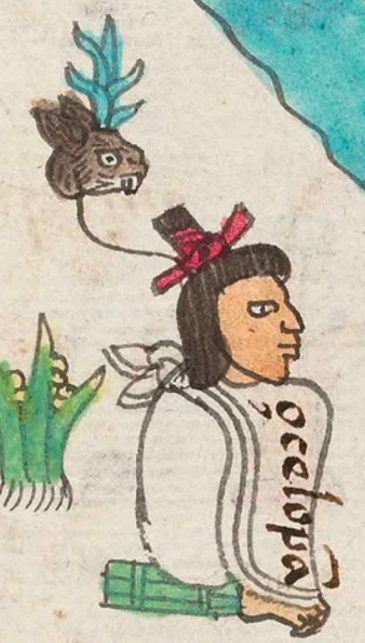Acacitl (Mdz2r)
This compound glyph standing for the personal name Acacitl (also spelled Acacitli) has two parts. One is a jack rabbit (citli) in profile, looking to our right. It is painted a gray-brown, except for the jaw, the eye, and the teeth, which are white. Coming out of the top of this animal's head is a turquoise-blue reed plant (acatl) with a leader and four branches.
Stephanie Wood
The wild rabbit (citli) can sometimes serve as a phonetic indicator for "ci" in some manuscripts. Here, it seems to provide the -citl for Acacitl, but it still may be more phonetic than logographic. It is difficult to know.
Acacitl was the fourth ruler of the Mexica, credited as one of the founders of the capital city of Tenochtitlan. The historical contextualizing image shows a man seated on a green bundle, with a cape wrapped all the way around him and tied on one shoulder. His bare feet protrude from under the cape. His hairstyle involves short bangs and an overall length that covers his ears. On the top of his head is a standing ponytail wrapped and tied in red (perhaps a red leather thong). There is a gloss on his cape, but this one is a mistake. It says "ocelopā," and yet the glyph that is attached to his head is not an ocelotl (jaguar) skin flag. The page from which this example is extracted has another man with a gloss "Acaçitli," but a glyph for Ocelopan. So, the two glosses or the two glyphs have been inadvertently confused.
Stephanie Wood
c. 1541, or by 1553 at the latest
Stephanie Wood

aca(tl), reed or cane, https://nahuatl.wired-humanities.org/content/acatl
ci(tli), jack rabbit, https://nahuatl.wired-humanities.org/content/citli
la liebre americana, conejo gato; o recipiente para agua?
Stephanie Wood
Codex Mendoza, folio 2 recto, https://digital.bodleian.ox.ac.uk/objects/2fea788e-2aa2-4f08-b6d9-648c00..., image 14 of 188.
Original manuscript is held by the Bodleian Libraries, University of Oxford, MS. Arch. Selden. A. 1; used here with the UK Creative Commons, “Attribution-NonCommercial-ShareAlike 3.0 License” (CC-BY-NC-SA 3.0)

